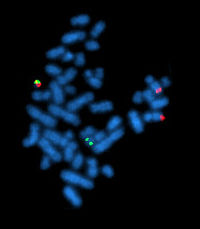
Photo from wikipedia
ABSTRACT Introduction The development of high-throughput sequencing technologies and the relentless pursuit of quality translational and clinical research allowed us to understand the leukemogenesis driven by recurrent mutations and design… Click to show full abstract
ABSTRACT Introduction The development of high-throughput sequencing technologies and the relentless pursuit of quality translational and clinical research allowed us to understand the leukemogenesis driven by recurrent mutations and design targeted therapies. As a result, the landscape of standard acute myeloid leukemia (AML) therapy has remarkably changed; only within the last few years, eight new agents were approved by the Food and Drug Administration for patients with AML. Areas covered Although the addition of a new arsenal of AML drugs provides more options for patients, therapy decisions have become more challenging than it used to be. In the first section of this review, we summarized the clinical development of conventional combination regimens in AML, and in the second part, we focused on the development of novel and conventional chemotherapy combinations. Acute promyelocytic leukemia will not be discussed in this review. Expert opinion The recurrent genomic aberrancies are not solely of prognostic relevance but can help with therapeutic decision-making at both diagnosis and relapse. Many challenges still remain to further improve on the survival of patients with AML, particularly for those with complex karyotype, secondary AML, or TP53 mutations. However, the pace of clinical drug development programs suggests a brighter future for our patients with AML.
Journal Title: Expert Review of Anticancer Therapy
Year Published: 2020
Link to full text (if available)
Share on Social Media: Sign Up to like & get
recommendations!